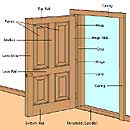
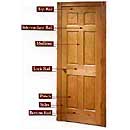
| q Active Door | q French Door / Arch Top | q Ornament |
| q Arch Door | q Hinges | q Pre-Hung |
| q Blueprint | q Jambs | q Rough Opening |
| q Caming | q Kiln-Drying | q Round Top |
| q Carving | q Layout | q Sidelight |
| q Casing | q Lintel | q Slab |
| q Certificate of Authenticity | q Lockset | q T-Astragal |
| q Cylinder Bore | q Lock - Bored | q Teak |
| q Dead Bold | q Lock - Mortise | q Taengwood |
| q Door Types | q Measure Rectangle Door | q Transom |
| q Door Shutter | q Measure Arched Door | q Quality |
| q Finishing | q Molding | q Unit |
| q Flush Bolts | q Muntons | q Wood Species |
| q Frame | q Out-Swing (Garage) | |
| q French Door | q Orientation | |
|
Door Terms, Definitions, Dictionary, Glossary, Encyclopedia and Terminology with Pictures |
|
||||
| Send email to The-Wood® Studio >> [ MAIL ] | |||||
|
|
|||||
Active Door: The door people use every time they enter or leave the house. When there are double doors, it is the door that opens with an entry set knob or lever. The other door is called the inactive door and opens when the flush bolts are released.
 |
 |
| Door Anatomy I | Door Anatomy II |
Antique Brass: Finish on hardware that has a brown color.
Arch Door: Door with arched top rail and arched frame. Called also "Round Top Door"
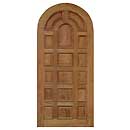 |
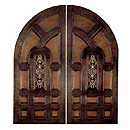 |
| Single Arch Door | Arch Double Door |
Backset: The distance from the edge of the door to the center of the hole drilled for your entry set knob, lever or deadbolt.
Blueprint: a detailed plan, a photographic print showing dimensions, front, top and side views used for mechanical drawings, house and door construction, etc.,
Brick mold: Exterior trim that covers seam between jamb and wall. [ Back to Index ]
Caming: Metal parts of the glass design. Metal options include lead, brass, copper, zinc (silver), or patina (black).
Carving: Authentic hand carving by best Thailand’s craftsmen. No routers, no machine tools are used. Over 4,000 carving styles available for doors frames casing and lintels in many categories such as Americana patriotic American eagle USA state POW embassy consulate president flag animal horse bird lion tiger eagle bear dog elephant rhino Pegasus unicorn peacock deer Asian Chinese Indian Hindu Japanese Korean corporate pattern business commercial company logo emblem crest monogram name initial Disney drawing classic character Mickey Mouse Pluto Pinocchio dragon European Asian Chinese Indian American Hindu mythology god goddess angel gargoyle beast chimera religious mermaid warrior nautical topics dolphin blue whale killer whale sailboat yacht fish wildlife outdoor carving flower tree country farm nature hunting fishing flying sailing human models woman man erotic nude child architectural style Renaissance Victorian Moroccan Mexican Egyptian Persian Roman Greek Gothic Indian Arabic Thai Khmer Asian Oriental Chinese Japanese Hindu and more... [ Back to Index ]
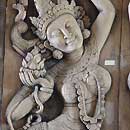 |
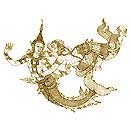 |
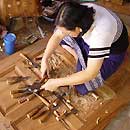 |
| Carving Design | Custom Carving | Door Carving |
Casing: A wooden trim around doors that covers seam between jamb and wall. It has a strong impact on the overall style, appearance, and proportion of door opening as well as the overall style of your home's interior. On the practical side, it conceals the gap between the door frame (called a jamb) and the rough opening and helps to hold the frame in the opening. Casing can be relatively plain such as square-edge design or detailed, such as colonial-style, French-style, Asian-style or Mexican-style molding.
|
|
|
Casing |
Casing > decorative
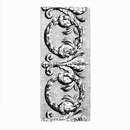 |
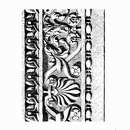 |
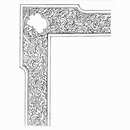 |
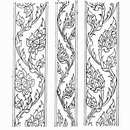 |
| casing-101 | casing-102 | casing-103 | casing-104 |
Certificate of Authenticity :: Every door we design and make is by order only. This is an original and authentic product. It is genuine and the only one made by The-Wood Studio. It is not a replica, a rebuild or repair; it has been newly built by skilled artisan. No two doors are identical, thus making each one of a kind. Only authentic hand carving is performed, no routers or machine tools of any type are used. [ Back to Index ]
Custom Glass: Original pattern of beveled and stained glass panels.
Cylinder Bore: Refers to a machining procedure that requires a round hole to accommodate a standard entry set. The diameter of the hole is 2-1/8" drilled in a door for an entry set knob, lever or deadbolt. [ Back to Index ]
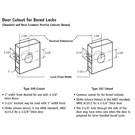 |
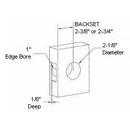 |
 |
| Standard Cylinder Bore | Door Drilling | Cylinder Bore / p1 |
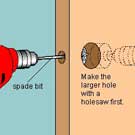 |
 |
 |
| Cylinder Bore / p2 | Cylinder Bore / p3 | Cylinder Bore / p4 |
Deadbolt: Locking mechanism for an entrance door or other door. Deadbolts can be a single cylinder or double cylinder. With a single cylinder deadbolt, a key is used on the outside and is turned by hand on the inside. With a double cylinder deadbolt, a key is used on both sides. Double cylinders are only recommended where no one needs to go through a door in case of an emergency. [ Back to Index ]
Door Types: There are four (4) general types of doors based on door shape:
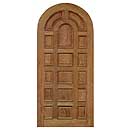 |
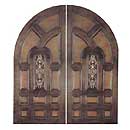 |
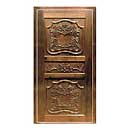 |
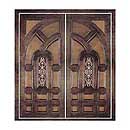 |
| Round Top (SD) | Round Top (DD) | Rectangular (SD) | Rectangular (DD) |
Door Shutter: A place where double door meet together..
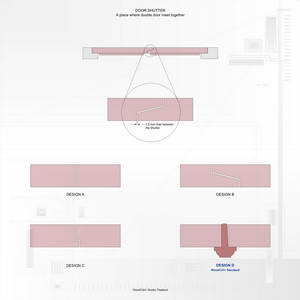 |
| DOUBLE DOOR SHUTTERS |
| (1) | 12-Step PermaLane II® Finish System | |
| (2) | Penetrating wiping stain sets the color | |
| (3) | Three Separate coats of alkyd moisture seal with fine sanding between coats | |
| (4) | Two coats of imported from Germany ‘Bayer Brand’ catalyzed Poly-Urethane with ultraviolet absorbers. Light sanding between coats | |
| (5) | Stain brightener applied | |
| (6) | Detailed hand rubbed to smooth satin finish |
Flush Bolts: Bolts mounted in a door to lock a door in place. These bolts slide up into the jamb above the door and down into the threshold or floor below the door. They are primarily used on double doors where one door is locked in place and the other door is the one mainly used (active door). When needed the door locked in place with the flush bolts can be opened. Flush bolts are housed in a T-Astragal. Examples below... [ Back to Index ]
 |
 |
 |
| Flush Bolt | Flush Bolt | Flush Bolt |
Frame: The set of jambs that holds the door unit together. The door is pre-hung in the frame.
French Door: A door with glass panels separated by wood muntons (one light, five light, six light, eight light, ten light or fifteen light)
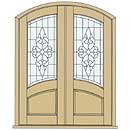 |
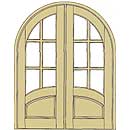 |
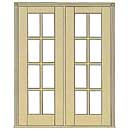 |
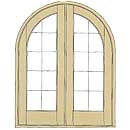 |
| One (1) Light | Six (6) Light | Eight (8) Light | Ten (10) Light |
French Door / Arch Top: Door with arched top rail and arched frame. [ Back to Index ]
 |
| Arch Top French Door |
Hinges: The metal objects that attach your door to the jamb, normally with screws. They can be made from brass, steel, iron or other metals.
In swing: When the door opens into the house when opened.
Jambs: The wood that surrounds the door unit. This is your frame to which the door unit (door, doors, and/or doors and sidelights) is attached. Jamb is a part of a door frame that runs vertically between the header and sill. Jamb extensions or casing can be used to create a frame that matches the depth of existing walls. The top member of a door frame consists of a head jamb, two side jambs and a threshold or sill. [ Back to Index ]
Kiln-Drying: The wood is kiln dried for 2 weeks to a moisture content of 10-12% and has an additional week or so of "resting" to allow the wood to reabsorb moisture in the air. This process ensures that the wood regains its dimensional stability and will not warp or split. This critical stage of reabsorbing moisture allows the doors to withstand the rigors of climatic change.
Knob: Round part of door handle that you hold with your hand. The knob can be made of brass, porcelain, steel, glass, iron or other products.
Layout: Design plan (detailed arrangement) of rails, mullions, panels, stiles, casing, ornaments, lintels and carving [ Back to Index ]
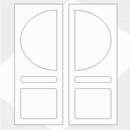 |
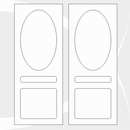 |
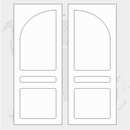 |
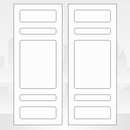 |
| layout-101 | layout-102 | layout-103 | layout-104 |
Left-Hand: Term used to describe which way a door is hung on the jamb. As viewed from outside, the side the hinges are on and the door swings into the house.
Lever: Has the same function as a knob, except is longer and thinner. To open a door, levers are pushed down. Beside the decorative uses of a lever, they are also used in applications where someone is handicapped and cannot grasp a knob very well. [ Back to Index ]
Lintel: Decorative carving on the wall just above the door. Lintels are made in teak, taeng wood, monkey wood, gypsum, sandstone, terra-cotta, cement and in fiberglass. All lintels are made on special orders only..
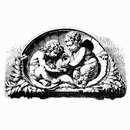 |
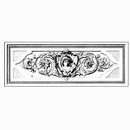 |
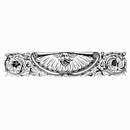 |
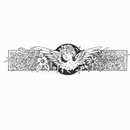 |
| lintel-101 | lintel-102 | lintel-103 | lintel-104 |
Lockset: The complete set of locking hardware mechanism for a door such as Mortise Lock or Bored Lock... [ Back to Index ]
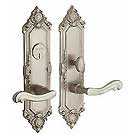 |
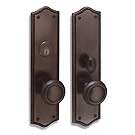 |
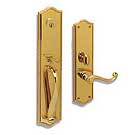 |
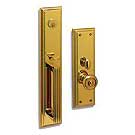 |
| Victorian Lockset | Antique Lockset | Brass Lockset | Modern Lockset |
Lock - Bored: Term "Bored Lock" describes how the lock fits into round holes which are bored or drilled into the face and edge of the door. It's an assembly of a tube-like casing and its inner locking mechanism. Bored cylindrical lock is one in which a hole must be drilled into the face of the door, as opposed to the edge of the door (as is the case with a mortise lock). Typically, the hole is sized from 1.5 inches to 2.125 inches and is centered 2.5 inches to 5 inches from the leading edge of the door.The bored cylindrical lock owes its existence to discovering a more cost effective method of locking doors. The previous norm, the mortise lock, is a more complex device, and its higher manufacturing cost as well as its more labor intensive installation made the bored cylindrical lock an ideal substitute, both in price and functionality. The great majority of locks now in use on residences are of this type. [ Back to Index ]
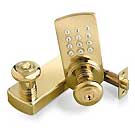 |
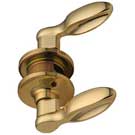 |
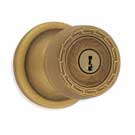 |
 |
| Bored Lock / p1 | Bored Lock / p2 | Bored Lock / p3 | Bored Lock / p4 |
Lock - Mortise:
Term "Mortise Lock" describes how the lock case fits into a rectangular shaped
cavity in the edge of a door. This type of lock is enclosed within the edge of a
door, so that it cannot be seen or removed when the door is closed. Mortise lock
is one which requires a pocket, or mortise, to be cut into the door, cabinet
door, or piece of furniture into which the lock is installed. Typically mortise
locks have been used on older buildings before the advent of bored cylindrical
locks, but in more recent times they have become a staple of commercial
construction and higher end residences. The parts included in the typical
mortise lock are the lock body (the part which is installed inside the door);
the lock trim (which may include any number of different designs of knobs,
levers, handle sets and pulls); and the keyed mortise cylinder which operates
the locking/unlocking function of the lock body.
Installation of the mortise lock cannot be done practically by the average home
owner since it is labor intensive and requires a working knowledge of basic
woodworking tools. Many installation specialists utilize a mortising jig which
makes the actual cutting of the pocket a precise operation, but the subsequent
installation of the external trim may prove to be problematic if the installer
is inexperienced.
Although the installation of the mortise lock actually weakens the structure of
the door, it does offer more versatility to the external trim and to the
functionality of the lock. Where the common bored cylindrical lock lacks the
architecture required for ornate or solid cast knobs and levers, the mortise
lock can accommodate heavier return springs and more solid internal mechanisms
to make this possible. Further, the mortise lock will commonly accept a wide
range of other manufacturers' cylinders and keyways so that it may conform to
existing lock hardware on site.
[ Back to Index ]
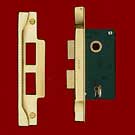 |
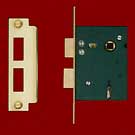 |
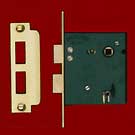 |
| Mortise Lock / p1 | Mortise Lock / p2 | Mortise Lock / p3 |
Machining: The preparation for the entry set so that it will operate properly in the door. (see Bore and Mortise).
Measuring a Door (slab):
To determine the size of your replacement door you will need to measure exactly your old door. For double door taking measurement of one slab is sufficient. We only need three (3) numbers. You should take a width, height and thickness of your old door and send to us by email.
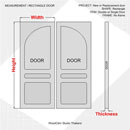 |
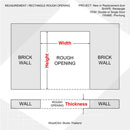 |
| Door (slab) Measurement | Rough Opening Size |
Measuring a Rough Opening:
For pre-hung doors and entire entrance units requiring a jambs or frames, we need the measurements of your rough opening. Rough opening measurements are to be taken both horizontally and vertically.
It is easiest to do this when there is no door installed. If a pre-hung door or old entrance unit occupies the current rough opening the measurements should be taken only after removing any and all casing and moldings which will prevent you from seeing the actual rough opening surrounding the door.
Measure the actual wall opening in which pre-hung door will be installed. Measure the opening's width across the empty space. After that, measure the opening's height as well as the wall thickness. The wall thickness is needed to determine depth of door jambs. Your door will be made approximately 3/16" smaller on the width and ¼" shorter on the height of your actual measurements. It'll minimize the amount of trimming (if any) you or your builder will have to perform during the installation process. [ Back to Index ]
Measure Arched (round top) Door
Measuring an Arch Door (slab):
To measure arched or round top door is a little more involved than standard rectangle doors.
- First take your standard (Width) measurement of the slab.
- Then you must measure your height from the bottom up to the beginning of the arch (Height B).
- Next measure the height from the bottom to the peak of the arch in the very middle (Height A).
- Using a Kraft paper (cardboard or poster board) trace a simple but precise pattern of the arch or round top opening. Trace the arch at the location on your existing jamb where the arched top of the door will actually occupy when in the closed position.
This pattern on paper will need to be mailed to us. This will insure that you door will fit precisely into your existing opening. Please feel free to contact us. We will be happy to work with you on any of these details.
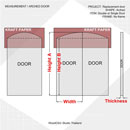 |
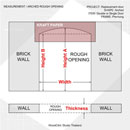 |
| Arched Door Size | Rough Opening Measurement |
Measuring an Arch Rough Opening:
Provide template: Make an exact duplicate of door rough opening. Usually two persons are required to make a good template.
Kraft Paper Method:
- First take your standard (Width) measurement of the opening across the empty space.
- Then you must measure your height from the bottom up to the beginning of the arch (Height B).
- Next measure the height from the bottom to the peak of the arch in the very middle (Height A).
- Using a Kraft paper (cardboard or poster board) trace a simple but precise pattern of the arch or round top opening. Trace the arch along the wall where the arched top pre-hung door unit will actually be placed.
This pattern on paper will need to be mailed to us. It will insure that your pre-hung door will fit precisely into the existing opening.
In addition to we require a measurement of the wall thickness. The wall thickness is needed to determine depth of door jambs. Your door will be made approximately 3/16" smaller on the width and ¼" shorter on the height of your actual measurements. It'll minimize the amount of trimming (if any) you or your builder will have to perform during the installation process. Please feel free to contact us. We will be happy to work with you on any of these details.
Tip: One Person should hold a large sheet of heavy Kraft paper across arch top of a door. Cellophane tape can be use to aid in stretching Kraft paper tightly over front site. Or, the paper can be taped to plywood or stiff cardboard while marking, then be removed before mailing it to us. A second person marks outline of edge of door opening with a soft pencil as accurately as possible. [ Back to Index ]
Molding: A decorative wooden strip used for ornamentation, carving or finishing.
|
|
|
Molding |
Mortise: An elaborate machining process for special entry sets called a mortise lock.
Mull cap: Interior and exterior trim for seam between door and sidelight. [ Back to Index ]
Muntons: Wooden trim that holds panels of glass in the door which makes a style of a French door, such a five light, ten light, etc. A door or window with panels of glass separated by muntons. Teakwood muntons (muttons) bar window with clear beveled glass in between.
|
|
|
Teak Muntons |
Ornament: Additional decorative accessory made in wood or metal (not a door hardware) which adds a unique grace and beauty, a manner of very special quality that adorns. It is an accent whose virtues or graces add luster to the door.
 |
 |
 |
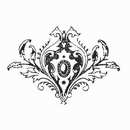 |
| ornament-101 | ornament-102 | ornament-103 | ornament-104 |
Out swing: When the door swings to the outside of the house when opened. Commonly used in garage doors. [ Back to Index ]
|
|
|
Right Hand Out-Swing Door |
Door Direction
- Out Swing Door: a door that opens away from the inside of a home, building or room.
- In Swing Door: a door that opens inside or towards the inside of a home, building or room.
- Swing Door (swinging): a door that can swing open in both directions.
- Sliding Door: a door that move easily and without interruption over a surface.
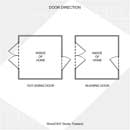 |
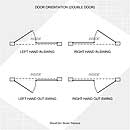 |
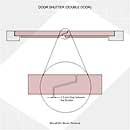 |
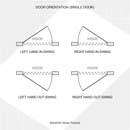 |
| Door Direction | Double Door Orientation | Door Shutter | Single Door Orientation |
Door Orientation
Left Hand Door: a door that opens on or to the left. A door that opens on or towards the side of your body that is to the west when you are facing north
Right Hand Door: a door that opens on or to the right. A door that opens on or towards the side of your body that is to the east when you are facing north
Door Shutter
A place where double door meet together. A center part (middle) of a double door when they're closed. A part of a double door that closes (close over) by bringing both moving parts (slabs) together. A double door formed by complete closure. [ Back to Index ]
Pre-Hung: Doors or combinations of doors and sidelights put together with jambs, hinges, threshold, T-Astragal, and trim to make a total working door system (a unit).
Right-Hand: Term used to describe which way a door is hung on the jamb. As viewed from the outside, the side the hinges are on and the door swings into the house.
Rough Opening: Opening in the wall for your door and/or sidelights before any framing material has been applied. This space must be slightly larger then total size of the door and frame together. [ Back to Index ]
Round Top: Door with round top rail or transom.
|
|
|
Round Top |
Sidelight: Fixed panel of wood and glass next to door.
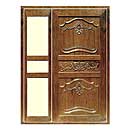 |
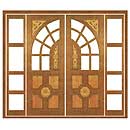 |
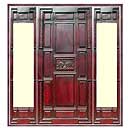 |
| One Sidelight (SD) | Two Sidelights (DD) | Two Sidelights (SD) |
Slab: Door only or sidelight only. No frames, jambs or parts added to make door operate. [ Back to Index ]
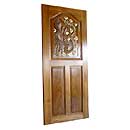 |
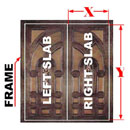 |
|
| Door Slab | Door Slab (DD) |
T-Astragal: Vertical piece of wooden molding that fits between double doors to provide an effective weather seal. It is attached to the inactive door of a double door unit. It houses the flush bolts. Blueprint and examples below…
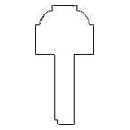 |
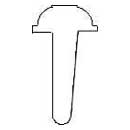 |
|
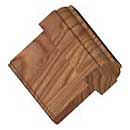 |
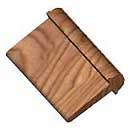 |
|
|
Types of T-Astragal |
||
Genuine Burmese Teak or Teakwood: Latin name "Tectona Grandis Linn". Teak or Golden Teak is the king of hardwoods and it's one of the world's most valuable timbers, recognized for its durability and stability. Teak is more durable than any other hardwood and has unparalleled rich beauty. Teak can withstand all types of weather. Ancient Burmese and Thai royalty considered teak to be a royal tree. It has been the pillar of the shipbuilding industry for centuries. The decks of the Titanic were covered in Teak, and the wood is as good today as the day she sank on 1912. Teak is also used in the Middle East oil industry as one of the very few timbers that can withstand the punishing heat of the desert and will not readily catch fire. Teak can withstand harsh chemicals, and is resistant to fungi, rot and termites. Unlike other woods, teak does not turn black when in contact with metals. It looks best when applied transparent and light colors...
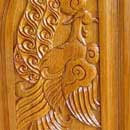 |
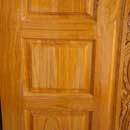 |
| Teakwood (Teak) | Tectona Grandis Linn |
Teak is the common name for “Tectona grandis”, a large deciduous tree of the family Verbenaceae, or its wood, one of the most valuable timbers. Teak has been widely used in India for more than 2,000 years. The name teak is from the Malayan word tekka. The tree has a straight, but often buttressed, stem (i.e., thickened at the base), a spreading crown, and four-sided branch lets with large quadrangular pith. The leaves are opposite or sometimes whorled in young specimens, about 0.5 meter (1.5 feet) long and 23 centimeters (9 inches) wide. In shape they resemble those of the tobacco plant, but their substance is hard and the surface rough. The branches terminate in many small white flowers in large, erect, cross-branched panicles. The fruit is a drupe (fleshy, with a stony seed), two-thirds of an inch in diameter. The bark of the stem is about 1.3 cm thick, gray or brownish gray, the sapwood white; the unseasoned heartwood has a pleasant and strong aromatic fragrance and a beautiful golden-yellow colour, which on seasoning darkens into brown, mottled with darker streaks. The timber retains its aromatic fragrance to a great age. Native to India, Burma, and Thailand, the tree grows as far north as about the 25th parallel in these areas and to the 32nd parallel in the Punjab. The tree is not found near the coast; the most valuable forests are on low hills up to about 3,000 feet. Stands are also found in the Philippines and in Java and elsewhere in the Malay Archipelago. Teak is also planted in Africa and Central America. During the dry season the tree is leafless; in hot localities the leaves fall in January, but in moist places the tree remains green until March. At the end of the dry season, when the first monsoon rains fall, the new foliage emerges. Although the tree flowers freely, few seeds are produced because many of the flowers are sterile. The forest fires of the dry season after the seeds have ripened and have partly fallen, impede the spread of the tree by self-sown seed. Teak trees on good soil have attained an average height of 18 m in 15 years, with a girth, breast high, of 0.5 m. In the natural forests teak timber with a girth of about 2 m (diameter of 0.6 m) is never less than 100 and often more than 200 years old. Mature trees are usually not more than 150 ft high. Due to the oil and rubber found naturally in the wood, teak has a greater ability to withstand the elements than any other wood. For this reason it has been the preferred choice for boats, and in fact, it has been used on aircraft carrier decks! This is because of its ability to resist splintering, warping and rotting. (If left un-oiled, our furniture will turn a soft dove gray when allowed to remain outdoors. This process will take approximately one year.) Teak timber is valued in warm countries principally for its extraordinary durability. The timber is practically imperishable under cover. Teakwood is well know since early/ancient times as a valuable resource due to its long life reliability and weather resistance as well as its workable qualities. Pieces of teak have been found (in India) over 200 years old and still intact. Teakwood is used for shipbuilding, fine furniture, door and window frames, wharves, bridges, cooling-tower louvers, flooring, paneling, railway cars, and Venetian blinds. An important property of teak is its extremely good dimensional stability. It is strong, of medium weight, and of average hardness. Termites eat the sapwood but rarely attack the heartwood; it is not, however, completely resistant to marine borers. Teak also refers specifically to the wood and its characteristic color, which ranges from olive to yellowish gray or moderate brown. Teak furniture dates back prior to the 19th century used mainly by the Chinese for export to Europe. The Victorian era also incorporated the use of teakwood during the mechanical era of the 1840’s with the invention of presses, veneer cutters etc which enabled them to create decorative elegant high class furniture. Another factor here is transportation (shipping) was also becoming more advanced. Burma produces most of the world's supply, India, Thailand, Indonesia, and Sri Lanka (Ceylon) ranking next in production... [ Back to Index ]
|
Latin name "Shorea Obtusa". Taeng or Modulus of Elasticity is a hardwood grown in Malaysia and Indonesia. Natural color of the wood varies from dark reddish to mixture of yellow and white. Taeng is as hard as Mahogany therefore carving on Taeng is not as fine as on Teak. Taeng is about 30-40% less expensive than Teak. It has a coarse grain and provides a good durability. Taeng is not termite resistant by nature as Teak therefore protective chemicals are applied. Taeng looks best when stained in darker colors. [ Back to Index ] |
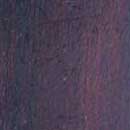 |
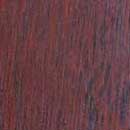 |
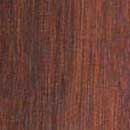 |
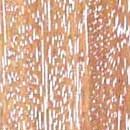 |
| COLOR-O3 | COLOR-O1 | COLOR-07 | COLOR-10 |
Threshold: The part of the door unit which is attached to the floor under the door.
Transom: Fixed plain wood, carved wood or window light mounted in the wall above the door. [ Back to Index ]
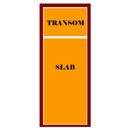 |
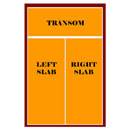 |
| Transom (SD) | Transom (DD) |
Quality: The-Wood Studio is Thailand's only door designer, manufacturer and exporter which quality match US, Canadian and European standards, please see Door Specifications for details...
Unit: All parts needed to hang the door and/or sidelights. The parts include Jambs, Hinges, Weather-stripping, Casing, Brick mold, Threshold; Flush Bolts and a T-Astragal on double doors and a sweep on an in swing unit.
Wood Species: Wood used to build doors and frames showing its hardness index. Comparison of Asian hardwoods with wood available in North America and Europe. ** The-Wood Studio premier hardwoods [ Back to Index ]
| Wood Common Name | Wood Latin Name | Hardness Index |
| Makha Wood | Afzelia Xylocarpa Craib | 2600 |
| Red Wood ** | X. Kerii | 2570 |
| Asian Rosewood ** | Pterocarpus Macrocarpus | 2450 |
| Taeng (Modulus of Elasticity) ** | Shorea Obtusa | 2200 |
| Mahogany | Melia Genus | 2200 |
| Pecan Hickory | Carya Illinoinensis | 1820 |
| Bamboo | Dendrocalamus Hamiltonii | 1800 |
| Maple | Acer Macrophyllum | 1450 |
| White Oak | Quercus Alba | 1360 |
| Teakwood (Teak) ** | Tectona Grandis Linn | 1150 |
| Walnut | Juglans Nigra | 1010 |
| Black Cherry | Prunus Serotina | 950 |
| Rubber Wood | Hevea Brasiliensis Muell Arg. | 900 |
| Monkey Wood | Samanea Saman Merr. | 760 |
| Table Mountain Pine | Pinus Pungens | 690 |
|
Updated 27-Mar-2005 |
Copyright © The-Wood 2005 All Rights Reserved